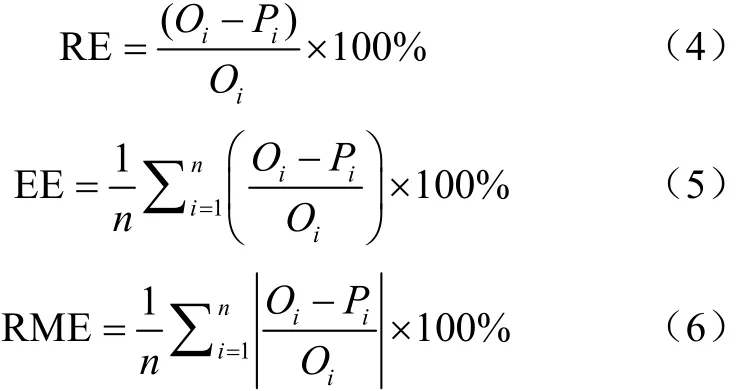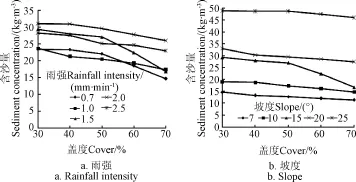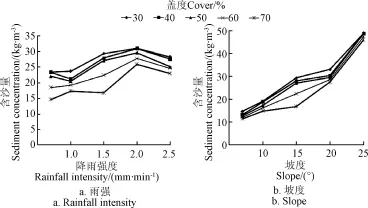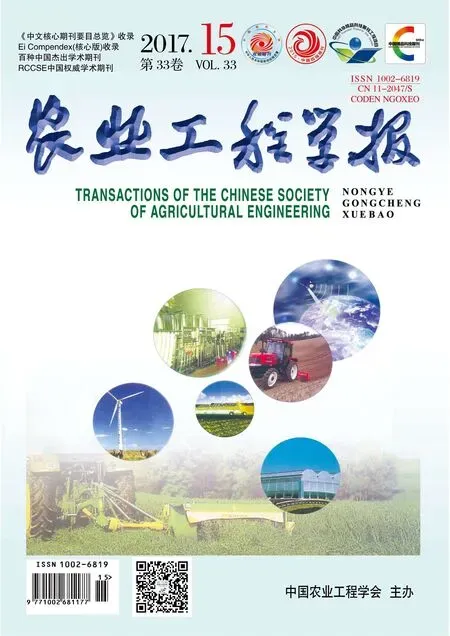草地植被覆盖度坡度及雨强对坡面径流含沙量影响试验研究
王栋栋,王占礼,2※,张庆玮,张琪琳,田娜玲
草地植被覆盖度坡度及雨强对坡面径流含沙量影响试验研究
王栋栋1,王占礼1,2※,张庆玮1,张琪琳1,田娜玲1
(1. 西北农林科技大学水土保持研究所 黄土高原土壤侵蚀与旱地农业国家重点实验室,杨凌 712100;2. 中国科学院水利部水土保持研究所,杨凌712100)
为研究植被修复状态下径流含沙量变化。该试验运用人工模拟降雨试验方法,分析了径流含沙量草被调控效益变化。结果:1)不同降雨强度或坡度下,平均径流含沙量随草被盖度的增大而减小,草被盖度从30%~70%,含沙量分别降低约10或5 kg/m3,可用线性方程显著描述。草被消减雨强对径流含沙量影响大于草被消减坡度的。平均径流含沙量随降雨强度或坡度的增大而增大,分别可用幂函数或指数函数方程显著描述,决定系数在0.5或0.8以上。2)基于单位水流功率建立幂函数模型决定系数为0.940,模型有效系数为0.986,说明模型模拟精度都较高。3)基于坡度、雨强和盖度建立指数函数模型决定系数为0.937,模型有效系数为0.894,说明模型模拟精度都较高。该研究可以预测草地坡面含沙量,为生态建设和流域管理提供指导。
土壤;侵蚀;径流;径流含沙量;草地植被;水力学参数;土壤侵蚀模型;盖度
王栋栋,王占礼,张庆玮,张琪琳,田娜玲. 草地植被覆盖度坡度及雨强对坡面径流含沙量影响试验研究[J]. 农业工程学报,2017,33(15):119-125. doi:10.11975/j.issn.1002-6819.2017.15.015 http://www.tcsae.org
Wang Dongdong, Wang Zhanli, Zhang Qingwei, Zhang Qilin, Tian Naling. Experiment on influence of cover degree, slope and rainfall intensity on sediment concentration of slope runoff in rangeland[J]. Transactions of the Chinese Society of Agricultural Engineering (Transactions of the CSAE), 2017, 33(15): 119-125. (in Chinese with English abstract) doi:10.11975/j.issn.1002-6819.2017.15.015 http://www.tcsae.org
0 引 言
片蚀是坡面薄层水流对土壤的分散和输移过程[1-2],是中国黄土地区垂直分布带土壤侵蚀的初级阶段[3]。径流含沙量变化是产流、产沙及水沙关系消长与演变过程的重要指标[4],也是衡量水土流失严重性的重要参数之一;另外径流含沙量变化可引起河床形态变化危及河道运行安全。自从退耕还草还林以来,草地得到很好的自行修复,片蚀径流含沙量也随之产生变化。建立草地坡面片蚀径流含沙量模型预测植被修复状态下径流含沙量对指导生态建设和加强流域管理有着极其重要作用。
坡面含沙量主要受雨强、坡度、坡长、植被影响,很多学者运用室内模拟降雨试验方法对此进行研究。李君兰等[5]对坡面细沟侵蚀发生过程中的坡面流速的沿坡变化进行了研究,试验结果表明坡面径流含沙量与坡度、雨强和坡面流速相关,与坡长无关。Liu等[4,6-8]研究了坡度雨强对含沙量变化过程影响,结果一致表明含沙量随降雨历时增加最终逐渐趋于稳定。盛贺伟等[9]研究在不同质地黄土、降雨强度和坡度条件下,水流含沙量均呈先减小后趋于平稳的规律;稳定含沙量随降雨强度和坡度的增大而增大。李浩宏等[10]试验结果表明片蚀水流平均含沙量随雨强和坡度的增大而增大,分别可用幂函数方程和对数方程描述。而关于有植被坡面的径流含沙量研究多采用野外降雨试验方法,研究内容集中在植被形态及种类对含沙量影响,近几年研究转向径流含沙量变化对水力学参数影响。杨帆等[11]和甘卓婷等[12]研究表明草被的盖度和种类以及草本植物结构间接的影响径流含沙量。甘卓婷等[12]还认为有草被覆盖的径流小区比裸坡的坡面径流含沙量小,并且坡面径流含沙量随草地植被生长阶段的增加而减小。吴卿等[13]采用人工径流冲刷模拟装置,研究了30%~40%及60%~80%草被盖度对侵蚀影响,研究结果表明在坡度和冲刷流量相同的条件下,植被盖度变化对径流含沙量有显著影响。Ghadiri等[14-15]研究认为植被过滤带前面的回水段泥沙沉积更为重要。肖培青等[16]、潘成忠等[17]、赵春红等[18],朱冰冰等[19]和吴淑芳等[20]通过野外人工模拟降雨试验研究径流含沙量对水力学参数影响,研究结果一致表明径流含沙量可显著影响水力学参数。综上可知,草地调控径流含沙量研究匮乏,使植被修复状态下径流含沙量变化认知缺失,以致无法科学进行生态建设和流域管理。
该试验运用人工模拟降雨试验方法,分析不同草地植被盖度、雨强及坡度条件下坡面含沙量的变化,探求草地植被影响坡面径流含沙量的变化规律;确定最适合描述径流含沙量变化的水力学参数;基于坡度、雨强及盖度建立草被坡面径流含沙量模型,以及基于最佳水力学参数建立草被坡面含沙量模型。该研究一方面预测草地坡面含沙量,另一方面为生态建设和流域管理提供指导。
1 材料与方法
1.1 试验地点与供试土壤
试验在中科院水利部水土保持研究所黄土高原土壤侵蚀与旱地农业国家重点实验室人工模拟降雨大厅进行。试验土壤取自位于黄土高原腹地的陕西安塞(属于典型黄土丘陵沟壑区),土壤类型为黄绵土。
1.2 试验设备
试验主要设备包括径流小区及模拟降雨器。径流小区为移动式变坡度钢质小区,可调坡度范围为0°~30°,小区尺度为140 cm×120 cm×25 cm,底部按10 cm的间距开孔。试验所用降雨设备为侧喷式人工降雨设备,喷头安装高度14.5 m,雨滴上喷高度1.5 m,降雨均匀度大于80%[21],实际降雨高度为16 m,能够满足所有雨滴都能达到终点速度[22]。
1.3 试验小区装土
所有试验土壤自然风干并过5 mm筛,除去杂草和石块。当自然风干土壤的质量含水量低于设计含水量时,要往土壤中加适量的水以至达到设计含水量14%。小区装土之前,在底部铺设5 cm厚的天然细沙,用透水纱布覆盖,以保持土层的透水状况接近天然坡面。装填土壤厚度为20 cm。为保证装土的均匀性,按设计容重分层(每层5 cm)装填,每次试验均装填新土。填土时,采用边填充边压实,并在所有边界0.5 cm的范围都加以夯实,以减小由于边壁所造成的对入渗和产流产沙过程及坡面侵蚀微形态发育等方面的影响,并使下垫面土壤条件的变异性达到最小,保证试验土壤容重达到1.2 g/cm3。填土后,用刮板将表面刮平整。
1.4 草地小区建设及覆盖度确定
草地小区由先建成裸土小区后再在其上种草建成,草长出后要对草地进行管护,以保证草能种活、长成,包括施肥、病虫害防治、浇水等,待草长势稳定后即可进行试验。试验选取草种为草地早熟禾(Poa pratensis L.),种草方式为条带状种植。植被盖度(C)分别为30%、40%、50%、60%、70% 5个等级,草的长势稳定后可进行试验。每次降雨试验前用数码相机对草地小区垂直拍照,再将照片拿回室内用ImageJ得到准确的植被盖度,如与设计覆盖度不一致,则要对草冠进行适当修剪,以保证试验盖度与设计盖度一致。
1.5 试验坡度、试验雨强及试验场次
试验坡度(S)选取7°、10°、15°、20°、25° 5个等级。试验雨强(I)选取0.7、1.0、1.5、2.0、2.5 mm/min五个等级。1个坡度5个雨强5个覆盖度及1个雨强5个坡度5个覆盖度组合的草地小区试验45场次,重复2次,共90场。具体试验设计见表1。

表1 试验设计Table 1 Experiment Design
1.6 降雨历时及观测时间
降雨历时为40 min。开始产流后前6 min每隔1、2、3 min观测1次,以后每隔3 min观测一次,观测时间至降雨结束(最后1个观测时距小于3 min),用小桶接取时段全部径流泥沙。用高锰酸钾测定径流表层流速,用温度计测量浑水温度,然后计算出雷诺数并判定水流流态,将不同流态的表面流速乘流速修正系数计算获得水流断面平均流速[23]。小区出口的流量用小桶接取时段全样后,用天平称取浑水样质量,然后澄清、撇掉清水、烘干称质量后计算出径流含沙量(SC)。
1.7 水力学参数计算
根据有关学者论著计算切应力[24]、水流功率[25-26]、单位水流功率[27-28]等水力学参数。
坡面径流切应力是破坏土壤结构及分离土壤的主要动力,它将分离的土粒带入水流并携带出坡面。其表达式

式中τ为水流切应力,Pa;γ为水流的容重,N/m3;R为水力半径,m;J为水力坡度,J=sinθ,θ为床面坡度,(°)。
坡面径流对土壤侵蚀的过程是做功耗能的过程,因此该过程就具有一定的功率。水流功率被表述为单位面积水体的势能在时间尺度上的变化率,它表征了处于一定高度的水体沿坡流动时具有的势能。其表达式

式中ω为水流功率,W/m2;V为流速,m/s。
单位水流功率为单位质量水体对床面做功而消耗的功率。其表达式如下

式中U为单位水流功率,m/s;s 为单位面积,m2。
1.8 数据分析


采用Excel2003绘图及SPSS 18.0数据统计分析软件做相关性分析,将数据分成2组,一组27场数据基于坡度雨强盖度或最佳水力学参数(单位水流功率)建模,另外一组18场数据用来验证模型。具体验证指标见下式分析可知,不同盖度条件下,草地植被径流含沙量随降雨强度或坡度的变化趋势不同。同一坡度下雨强从0.7增加到2.0 mm/min,径流含沙量增加约10 kg/m3,雨强从2.0增加到2.5 mm/min,径流含沙量降低约3 kg/m3;同一雨强下坡度从7°增加到25°,径流含沙量增加约40 kg/m3。
式中RE是相对误差,%;EE平均相对误差,%;RME绝对相对误差,%;R2决定系数;NE是Nash模型有效系数[29],Oi是实测值,Pi是预测值,O平均实测值,P平均预测值,n样本数.
2 试验结果
2.1 草被盖度对平均径流含沙量的影响
图1为不同降雨强度条件下含沙量对盖度的响应。不同降雨强度或坡度下,平均径流含沙量随草被盖度的增大而减小,草被盖度从30%增加到70%,含沙量分别降低约10或5 kg/m3。由表2可知,不同降雨强度或坡度条件下,平均径流含沙量随草被盖度变化可用线性方程描述,方程可简化SC=−aC+b形式,决定系数在0.8以上,显著性水平为0.01。对比方程系数a发现,不同降雨强度下的方程系数整体大于不同坡度下方程系数。可见,草被消减雨强对径流含沙量影响明显大于草被消减坡度对径流含沙量影响。
图2为不同盖度条件下含沙量对降雨强度或坡度的响应。不同盖度条件下,平均径流含沙量随降雨强度或坡度的增大而增大。由表3可知,不同盖度下,径流含沙量随降雨强度变化可用幂函数方程描述方程可简化SC=−aIb形式,决定系数在0.5以上,显著性水平为0.01;随坡度变化可用指数函数方程描述,方程可简化SC=−aebs形式,决定系数在0.8以上,显著性水平为0.01。进一步

图1 不同雨强或坡度下含沙量随盖度变化Fig.1 Variations of sediment concentration with cover under different rainfall intensities or slopes

图2 不同盖度下含沙量随雨强或坡度的变化Fig.2 Variations of sediment concentration with rainfall intensity or slope under different cover

表2 不同降雨强度或坡度下草被盖度与平均径流含沙量的经验方程Table 2 Empirical equations between cover and sediment concentration under different rainfall intensities or slopes

表3 不同盖度下降雨强度或坡度与平均径流含沙量的经验方程Table 3 Empirical equations between rainfall intensity or slope and sediment concentration under different covers
2.2 草被盖度对黄土坡面径流含沙量与水力学参数耦合关系的影响
由表4可知,不同草地盖度下,径流含沙量与切应力和水流功率呈幂函数方程,决定系数在0.2~0.5,显著性水平为0.01。而不同草地盖度下,径流含沙量与单位水流功率呈对数方程,决定系数在0.7~0.9,显著性水平为0.01。对比决定系数可知,单位水流功率与径流含沙量决定系数最大,单位水流功率比切应力和水流功率更适合用来描述含沙量水动力过程。

表4 径流含沙量与水力学参数的经验方程Table 4 Empirical equations between sediment concentration and hydrodynamic parameters
2.3 径流含沙量模拟
2.3.1 基于坡度、雨强 和草被盖度模拟
在该试验条件下,雨强、坡度和草地盖度是影响坡面径流含沙量特征的3个主要因素,将27场次试验数据进行统计,分析坡面径流含沙量变化对雨强、坡度和草地盖度的响应关系,得到式(9)。

式中SC为含沙量,kg/m3;I为雨强,mm/min;S为坡度,(°);C为盖度,%。
式(9)表明,草被坡面径流含沙量对雨强、坡度和草地盖度的响应关系可用三元指数函数方程描述,显著性水平Sig<0.01。相对误差RE范围在−25.755~18.277之间,相对误差绝对值的平均值RME为10.650,平均相对误差EE为0.802,决定系数R2为0.937,模型有效系数NE达到0.894。说明基于坡度、雨强和盖度模型对实测值的模拟精度很高。
2.3.2 基于单位水流功率模拟
在本试验条件下,单位水流功率最适合用来描述含沙量水动力过程。基于此,将27场次试验数据进行统计,分析坡面径流含沙量变化对单位水流功率的响应关系,见式(10)。

式中SC为含沙量,kg/m3;U为单位水流功率,m/s。
式(10)表明,草被坡面径流含沙量对单位水流功率的响应关系可用幂函数方程描述,显著性水平Sig<0.01。相对误差RE范围在−32.781%~15.540%之间,相对误差绝对值平均值RME为10.280%,平均相对误差EE为−0.903%,决定系数R2为0.940,模型有效系数NE达到0.986。说明基于单位水流功率模型对实测值的模拟精度也很高。
3 讨 论
同一坡度不同雨强下,在中小雨强0.7增加到2.0 mm/min时,径流产生的动能只能分离表层土壤,土壤可蚀性系数很低,只要径流动能增加,侵蚀量就会急速增加,从而造成中小雨强0.7增加到2.0 mm/min,径流含沙量呈急速增加趋势。在大雨强2.0增加到2.5 mm/min时,径流需要分离深层土壤,而草被紧固较深层土壤可蚀性系数明显提高,分离出来土壤减少。再加上土壤入渗能力和蓄水能力有限,径流量随之增加。从而造成在大雨强情况下,径流含沙量呈降低趋势。同一雨强下坡度从7°增加到25°,试验坡面汇水量降低,重力作用和流速增加,侵蚀动能反而增加,而坡面土壤稳定性降低,可蚀性系数降低。从而造成坡度增加,径流含沙量呈急速增加趋势。
不同草地盖度下,径流含沙量与单位水流功率可呈显著的幂函数方程,决定系数0.7~0.9,最适合用来描述含沙量水动力过程。盛贺伟等[9]、李浩宏等[10]和Shih等[30]研究也一致认为单位水流功率最适合用来描述含沙量水动力过程,但这3位的试验条件为裸坡,盛贺伟等[9]在研究不同土质含沙量变化时考虑了土壤颗粒体积分形维数在含沙量中影响,径流含沙量与单位水流功率、土壤颗粒体积分形维数呈可呈显著的幂函数方程,可见径流含沙量与单位水流功率关系最为密切,但两者关系受土壤类型影响。草地坡面单位水流功率之所以与单位水流功率关系最为密切,原因是单位水流功率计算并没有考虑受植被影响很大的水深,其他水力学参数像切应力和水流功率的计算考虑了水深,造成其实际计算中误差变大,与含沙量的相关性显著降低。
通过对验证指标分析可知,2个含沙量模型对实测值的模拟精度都很高。虽然基于单位水流功率模型精度(NE=0.986)要比基于坡度雨强盖度模型精度高(NE=0.894),但考虑到模型的实用性,基于坡度雨强盖度模拟含沙量模型价值更高。验证指标也表明用单位水流功率模拟含沙量模型要低估实际值,而用坡度、雨强和盖度模拟含沙量模型要高估实际值,可能含沙量模型并没有有效估计草被减少含沙量作用。因为植被布局、根形态植被对含沙量影响一直是研究难点并且很难进行定量分析。这些问题造成模拟含沙量中误差产生,因此后期应继续加强植被布局、根形态植被对含沙量影响的定量分析。
4 结 论
1)不同降雨强度或坡度下,平均径流含沙量随草被盖度的增大而减小,草被盖度从30%增加到70%,含沙量分别降低约10或5 kg/m3,可用线性方程描述,决定系数在0.8以上,显著性水平为0.01。对比分析发现草被消减雨强对径流含沙量影响明显大于草被消减坡度对径流含沙量影响。不同盖度条件下,平均径流含沙量随降雨强度或坡度的增大而增大,可用幂函数方程描述;随坡度变化可用指数函数方程描述,决定系数在0.5或0.8以上,显著性水平为0.01。同一坡度下雨强从0.7增加到2.0 mm/min,径流含沙量增加约10 kg/m3,雨强从2.0增加到2.5 mm/min,径流含沙量降低约3 kg/m3;同一雨强下坡度从7°增加到25°,径流含沙量约增加40 kg/m3。
2)不同草地盖度下,径流含沙量与单位水流功率可呈显著幂函数方程,决定系数0.7~0.9,最适合用来描述含沙量水动力过程。基于单位水流功率建立模型决定系数R2为0.940,模型有效系数NE为0.986,说明模型模拟精度较高。
3)草被坡面径流含沙量对雨强、坡度和草地盖度的响应关系可用三元指数函数方程描述,显著性水平Sig<0.01。基于坡度、雨强和盖度建立含沙量模型的决定系数R2为0.937,模型有效系数NE达到0.894,说明模型模拟精度较高
[1] 杨明义,田均良. 坡面侵蚀过程定量研究进展[J]. 地球科学进展,2000,15(6):650-653.
Yang Mingyi, Tian Junliang. Research progress in erosion process on hillslope quantitatively[J]. Advance in Earth Sciences, 2000, 15(6): 650-653. (in Chinese with English abstract)
[2] 郑粉莉,高学田. 坡面土壤侵蚀过程研究进展[J]. 地理科学,2003,23(2):230-235.
Zheng Fenli, Gao Xuetian. Research progresses in hillslope soil erosion processes[J]. Scientia Geographica Sinca, 2003, 23(2): 230-235. (in Chinese with English abstract)
[3] 刘元保,朱显谟,周佩华,等. 黄土高原土壤侵蚀垂直分带性研究[J]. 中国科学院西北水土保持研究所集刊,1988(1):5-8.
Liu Yuanbao, Zhu Xianmo, Zhou Peihua, et a1. A study on the vertical zoning of soil erosion in the Loess Plateau[J]. Memoir of Northwestern Institute of Soil and Water Conservation Academia Sinica, 1988(1): 5-8. (in Chinese with English abstract)
[4] Liu June, Wang Zhanli, Yang Xiaomei, et al. The impact of natural polymer derivatives on sheet erosion on experimental loess hillslope[J]. Soil and Tillage Research, 2014, 139: 23-27.
[5] 李君兰,蔡强国,孙莉英,等. 坡面水流速度与坡面含砂量的关系[J]. 农业工程学报,2011,27(3):73-78.
Li Junlan, Cai Qiangguo, Sun Liying, et a1. Relationship between the spatial distribution of flow velocity and sediment concentration[J]. Transactions of the Chinese Society of Agricultural Engineering (Transactions of the CSAE), 2011, 27(3): 73-78. (in Chinese with English abstract)
[6] 卢嘉,郑粉莉,安娟,等. 降雨侵蚀过程中黑土团聚体流失特征研究[J]. 生态学报,2016,36(8):2264-2273.
Lu Jia, Zheng Fenli, An Juan, et al. 2016.An experiment study of Mollisol arrregate loss characteristics during rainfall erosion processes[J]. Acta Ecologica Sinica, 2016, 36(8): 2264-2273. (in Chinese with English abstract)
[7] 刘俊娥,王占礼,高素娟. 黄土坡面片蚀过程试验研究[J].水土保持学报,2011,25(3):35-39. Liu June, Wang Zhanli, Gao Sujuan. Experimental study of sheet erosion processes on loess hillslope[J]. Journal of Soil and Water Conservation, 2011, 25(3): 35-39. (in Chinese with English abstract)
[8] 郑子成,秦凤,李廷轩. 不同坡度下紫色土地表微地形变化及其对土壤侵蚀的影响[J]. 农业工程学报,2015,31(8):168-175.
Zheng Zicheng, Qin Feng, Li Tingxuan. Changes in soil surface micro-relief of purple soil under different slope gradients and its effects on soil erosion[J]. Transactions of the Chinese Society of Agricultural Engineering (Transactions of the CSAE), 2015, 31(8): 168-175. (in Chinese with English abstract)
[9] 盛贺伟,孙莉英,蔡强国. 黄土坡面片蚀过程稳定含沙量及其影响因素[J]. 地理科学进展,2016,35(8):1008-1016.
Sheng Hewei, Sun Liying, Cai Qiangguo. Steady sediment concentration of sheet erosion on loess slope and influencing factors[J]. Progress in Geography, 2016, 35(8): 1008-1016. (in Chinese with English abstract)
[10] 李浩宏,王占礼,申楠,等. 黄土坡面片蚀水流含沙量变化过程试验研究[J]. 中国水土保持,2015(3):46-49.
Li Haohong, Wang Zhanli, Shen Nan, et al. An experiment study of variation of sediment concentration of sheet erosion on loess slope[J]. Soil and Water Conservation of China, 2015(3): 46-49. (in Chinese with English abstract)
[11] 杨帆,程金花,张洪江,等. 坡面草本植物对土壤分离及侵蚀动力的影响研究[J]. 农业机械学报,2016,47(5):129-137.
Yang Fan, Cheng Jinhua, Zhang Hongjiang, et al. Effect of herb plants on soil detachment and erosion dynamics[J]. Transactions of the Chinese Society for Agricultural Machinery, 2016, 47(5): 129-137. (in Chinese with English abstract)
[12] 甘卓亭,叶佳,周旗,等. 模拟降雨下草地植被调控坡面土壤侵蚀过程[J]. 生态学报,2010(9):2387-2396.
Gan Zhouting, Ye Jia, Zhou Qi, et al. Effects of grass vegetations on the processes of soil erosion over slope lands in simulated rainfalls[J]. Acta Ecologica Sinica, 2010(9): 2387-2396. (in Chinese with English abstract)
[13] 吴卿,杨春霞,甄斌,等. 草被覆盖度对黄土坡面径流产沙影响的试验研究[J]. 中国水土保持,2010(9):56-58.
Wu Qing, Yang Chunxia, Zhen Bin, et al. An experiment study of effects of grass cover on soil erosion on loess slope[J]. Soil and Water Conservation of China, 2010(9): 56-58. (in Chinese with English abstract)
[14] Ghadiri H, Rose C W, Hogarth B. The influence of grass and porous barrier strips on runoff hydrology and sediment transport[J]. Transactions of the ASAE, 2001, 42(6): 1950-1958.
[15] Ligdi E E, Rpc M. Contour grass strips: A laboratory simulation of their role in soil erosion control[J]. Soil Technology, 1995, 8(2): 109-117.
[16] 肖培青,姚文艺,申震洲,等. 草被减流减沙效应及其力学机制分析[J]. 中国水土保持科学,2010(2):15-19.
Xiao Peiqing, Yao Wenyi, Shen Zhenzhou, et al. Reduction effects of grass on runoff and sediment and its mechanical mechanism[J]. Science of Soil and Water Conservation, 2010(2): 15-19. (in Chinese with English abstract)
[17] 潘成忠,马岚,上官周平. 含沙量对草地坡面径流泥沙沉积和水力特性的影响[J]. 水科学进展,2008,19(6):857-862.
Pan Chengzhong, Ma Lan, Shangguan Zhouping.Influence of sediment concentration on deposition of silt and runoff hydraulics on grassland[J]. Advances in Science, 2008, 19(6): 857-862. (in Chinese with English abstract)
[18] 赵春红,高建恩,王飞,等. 含沙量对坡面流水动力学特性的影响研究[J]. 农业机械学报,2013,44(9):79-85.
Zhao Chunhong, Gao Jianen, Wang Fei, el a1. Effects of Sediment concentration on Hydrodynamic Characteristics of Overland Flow[J]. Transactions of the Chinese Society for Agricultural Machinery, 2013, 44(9): 79-85. (in Chinese with English abstract)
[19] 朱冰冰,李占斌,李鹏,等. 草本植被覆盖对坡面降雨径流侵蚀影响的试验研究[J]. 土壤学报,2010,47(3):40l-407.
Zhu Bingbing, Li Zhanbin, Li Peng, et a1. Effect of grass coverage on sediment yield of rain on slope[J]. Acta Pedologica Sinica, 2010, 47(3): 401-407. (in Chinese with English abstract)
[20] 吴淑芳,吴普特,原立峰. 坡面径流调控薄层水流水力学特性试验[J]. 农业工程学报,2010,26(3):14-18.
Wu Shufang, Wu Pute, Yuan Lifeng. Hydraulic characteristics of sheet flow with slope runoff regulation[J]. Transactions of the Chinese Society of Agricultural Engineering (Transactions of the CSAE), 2010, 26(3): 14-18. (in Chinese with English abstract)
[21] 郑粉莉,赵军. 人工模拟降雨大厅及模拟降雨设备简介[J].水土保持研究,2004,11(4):177-178.
Zheng Fenli, Zhao Jun. Brief introduction of artificial simulated rainfall hall and simulated rainfall equipment[J]. Research of Soil and Water Conservation, 2004, 11(4): 177-178. (in Chinese with English abstract)
[22] 陈文亮,王占礼. 人工模拟降雨特性的试验研究[J]. 水土保持通报,1991,3(2):55-62.
Chen Wenliang, Wang Zhanli. Trial research on the behaviours of artificial rainfall by simulation[J]. Bulletin of Soil and Water Conversation, 1991, 3(2): 55-62. (in Chinese with English abstract).
[23] Horton R E, Leach H R, Van V1iet R. Laminar sheet flow[J]. Transactions of the American Geophysical Union, 1934, 15(2): 393-404.
[24] Foster G R, Huggins L F, Meyer L D. A laboratory study of rill hydraulics, II. Shear stress relationships[J]. Transactions of the ASAE, 1984, 27(3): 797-804.
[25] Bagnold R A. An approach to the sediment transport problem from general physics[J]. US Geological Survey Professional Paper, 1966, 422-i: 231-291.
[26] Prosser I P, Rustomji P. Sediment transport capacity relations for overland flow[J]. Progress in Physical Geography, 2000, 24: 179-193.
[27] Yang C T. Unit stream power and sediment transport[J]. Journal of the Hydraulics Division, 1972, 98: 1805-1826.
[28] Yang C T. Minimum unit stream power and fluvial hydraulics[J]. Journal of the Hydraulics Division, 1976, 102(7): 769-784.
[29] Nash J E, Sutcliffe J V. River flow forecasting through conceptual models part I-a discussion of principles[J]. Journal of the Hydrology, 1970, 10(3): 282-290.
[30] Shih H, Yang C T. Estimating overland flow erosion ca-pacity using unit stream power[J]. International Journal of Sediment Research, 2009, 24(1): 46-62.
Experiment on influence of cover degree, slope and rainfall intensity on sediment concentration of slope runoff in rangeland
Wang Dongdong1, Wang Zhanli1,2※, Zhang Qingwei1, Zhang Qilin1, Tian Naling1
(1. State Key Laboratory of Soil Erosion and Dryland Farming on the Loess Plateau, Institute of Soil and Water Conservation, Northwest A&F University, Yangling 712100,China;2.Institute of Soil and Water Conservation, Chinese Academy of Sciences and Ministry of Water Resources, Yangling 712100,China)
The purpose of this study was to model sediment concentration of sheet erosion on rangeland, which has a major impact on strengthening river basin management and controlling the source of soil erosion. The impact of herbaceous vegetation on sediment concentration under different slopes or rain intensities was studied by artificial rainfall experiment. The relationship of sediment concentration and slope gradient, rainfall intensity, and hydraulic parameters, such as shear stress, stream power and unit stream power, was investigated to derive an accurate experimental model. Each experiment soil pan with metal frames was 140 cm long, 120 cm wide and 2.5 cm deep. The experiment soil sample was collected from Ansai County, Shaanxi Province in China. After the soil was packed, herbaceous vegetation (Poa pratensis L.) was transplanted in a banded uniform layout. Poa pratensis L. was a gramineous plant, and the current year’s Poa pratensis L. was selected. The duration of all simulated rainfall events was 40 min. The experiment was conducted at 5 herbaceous vegetation cover densities (30%, 40%, 50%, 60%, and 70%), 5 rainfall intensities (0.7, 1, 1.5, 2, and 2.5 mm/min) and 5 slopes (7°, 10°, 15°, 20°, and 25°), respectively. All combinations were tested with 2 replicates of each run, a total of 90 experimental units. All statistical analyses were carried out using Excel or spss 18.0. Results show that: 1) Herbaceous vegetation not only decreases sediment concentration, but also reduces the effect of rainfall intensity or slope on it, which would increase with cover increasing. Cover increases from 30% to 70%, herbaceous vegetation decreases sediment concentration by more than 5 kg/m3, and reduces the effect of rainfall intensity or slope on it by more than 10 kg/m3. Under different slopes or rainfall intensities, sediment concentration decreases as linear equations with cover, and the relationship between sediment concentration and cover is significant (P<0.01). Under different covers, sediment concentration totally increases as power equations or exponential equations with rainfall intensity or slope, the relationship between sediment concentration and rainfall intensity is very well (P<0.01), and the relationship between sediment concentration and slope is also good (P<0.01). 2) Unit stream power is the parameter most suitably describing sediment concentration with an exponential equation among the 3 hydraulic parameters considered in this paper. Sediment concentration increases as shear stress or stream power increases, and both can be described by a logarithmic equation, but the relationship between sediment concentration and shear stress or stream power is poor. 3) Rainfall intensity, slope and cover can be used to predict sediment concentration with an exponential function accurately, which was satisfactory for predicting sediment concentration with the R2value of 0.937 and the NE (Nash coefficient) of 0.894. Meanwhile, unit stream power also can be used to predict sediment concentration with a power function equation, which was satisfactory for predicting sediment concentration with the R2value of 0.940 and the NE of 0.986. Vegetation species, layout and root morphology affect the simulation effect of sediment concentration on rangeland. In the later period, the vegetation species, layout and root morphology should be studied to quantify the sediment concentration and optimize the sediment concentration model.
soils; erosion; runoff; sediment concentration; herbaceous vegetation; hydrodynamic parameters; soil erosion model; cover
10.11975/j.issn.1002-6819.2017.15.015
S157
A
1002-6819(2017)-15-0119-07
2017-03-02
2017-07-09
国家自然科学基金资助项目(41471230,41171227);国家重点研发计划(No.2016YFC0402401);黄土高原土壤侵蚀与旱地农业国家重点实验室专项经费项目(A314021403-C2)
王栋栋,男,山东省东营人,博士生,主要从事土壤侵蚀与林草生态方面研究。杨凌 西北农林科技大学水土保持研究所,712100。
Email:1534849533@qq.com
※通信作者:王占礼,男,陕西榆林人,博士,研究员,博士生导师,主要从事土壤侵蚀过程及预报模型研究工作。杨凌 西北农林科技大学水土保持研究所,712100。Email:zwang@nwsuaf. edu. cn

